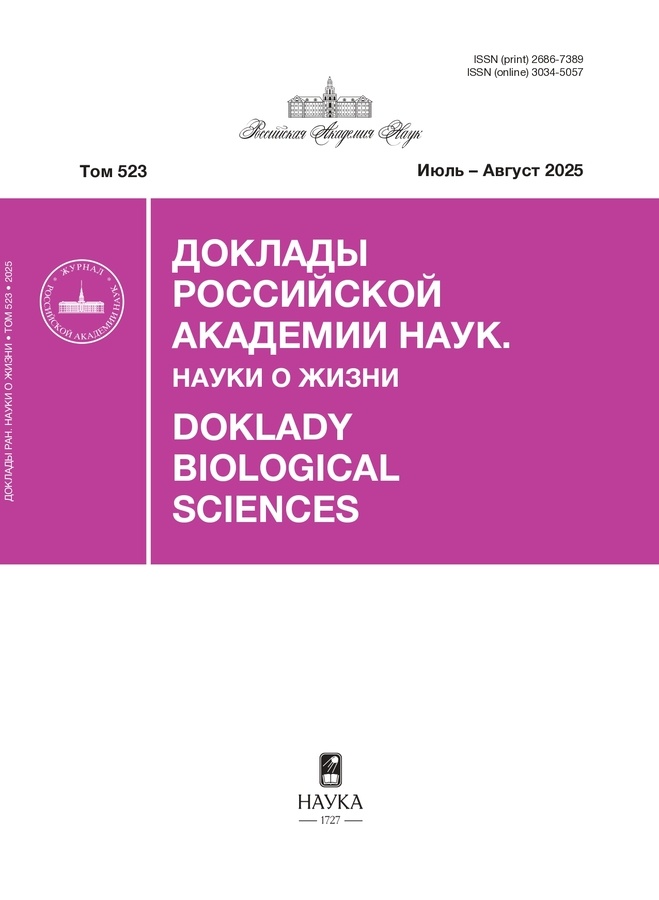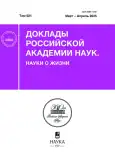Mycobiota of acorn worm Saccoglossus mereschkowskii (Hemichordata, Enteropneusta) and its habitats
- Authors: Ezhova O.V.1, Grum-Grzhimaylo O.A.1, Kokurkina J.А.1, Ekimova I.А.1, Gantsevich М.М.1, Malakhov V.V.1
-
Affiliations:
- Lomonosov Moscow State University
- Issue: Vol 521, No 1 (2025)
- Pages: 299-304
- Section: Articles
- URL: https://vestnik.nvsu.ru/2686-7389/article/view/684078
- DOI: https://doi.org/10.31857/S2686738925020217
- ID: 684078
Cite item
Abstract
It is known that the tissues and mucous of acorn worms contain phenolic compounds, which inhibit the activity of aerobic bacteria. In this work, the mycobiota of tissues, body surface lavages, and burrows of the acorn worm Saccoglossus mereschkowskii (Wagner, 1885) were studied. 3 species of fungi were found in the plating of intestine samples. 7 species were isolated from the body surface lavage of S. mereschkowskii. 5 species were found in burrow samples, and 15 species were found in the samples of sediment from the habitat of S. mereschkowskii. Plating of intact specimens, gill bars, and axial organ did not reveal the growth of mycelial fungi. This indicates that enteropneust tissues may have a fungistatic effect.
Full Text
About the authors
O. V. Ezhova
Lomonosov Moscow State University
Author for correspondence.
Email: olga_ejova@mail.ru
Biological Faculty, Department of Invertebrate Zoology
Russian Federation, MoscowO. A. Grum-Grzhimaylo
Lomonosov Moscow State University
Email: olga_ejova@mail.ru
Biological Faculty, N.A. Pertsov White Sea Biological Station
Russian Federation, MoscowJ. А. Kokurkina
Lomonosov Moscow State University
Email: olga_ejova@mail.ru
Biological Faculty, Department of Invertebrate Zoology
Russian Federation, MoscowI. А. Ekimova
Lomonosov Moscow State University
Email: olga_ejova@mail.ru
Biological Faculty, Department of Invertebrate Zoology
Russian Federation, MoscowМ. М. Gantsevich
Lomonosov Moscow State University
Email: olga_ejova@mail.ru
Biological Faculty, Department of Invertebrate Zoology
Russian Federation, MoscowV. V. Malakhov
Lomonosov Moscow State University
Email: olga_ejova@mail.ru
Biological Faculty, Department of Invertebrate Zoology, Academician of the RAS
Russian Federation, MoscowReferences
- Van der Horst C.J. Observations on some Enteropneusta // Videnskabelige meddelelser fra Dansk Naturhistorisk Forening i København. 1929. Vol. 87. P. 135–200.
- King G.M. Inhibition of microbial activity in marine sediments by a bromophenol from a hemichordate // Nature. 1986. Vol. 323. P. 257–259.
- Richards T.A., Jones M.D., Leonard G., Bass D. Marine fungi: their ecology and molecular diversity // Annual Review of Marine Science. 2012. V. 4. P. 495–522.
- Gonçalves M.F., Esteves A.C., Alves A. Marine fungi: Opportunities and challenges // Encyclopedia. 2022. V. 2. P. 559–577.
- Frisvad J.C., Samson R.A. Polyphasic taxonomy of Penicillium subgenus Penicillium. A guide to identification of food and air-borne terverticillate Penicillia and their mycotoxins // Studies in mycology. 2004. V. 49. P. 1–174.
- Domsch K.H., Gams W., Anderson T.-H. Compendium of Soil Fungi // Eching, Germany: IHW-Verlag. 2007. 672 p.
- Pitt J.I., Hocking A.D. Aspergillus and related teleomorphs // Fungi and Food Spoilage. 2009. P. 275–337.
- Ivanova N., Grainger C., Hajibabaei M. Glass fiber DNA extraction: A new inexpensive method for high throughput DNA isolation // CCDB Advances, Methods Release. No. 1. 2006.
- Osterburg H.H., Allen J.K., Finch C.E. The use of ammonium acetate in the precipitation of ribonucleic acid // Biochemical Journal. 1975. V. 147. P. 367–368.
- Бубнова Е.Н., Никитин Д.А. Грибы в донных грунтах Баренцева и Карского морей // Биология моря. 2017. Т. 43. С. 366–371.
- Бубнова Е.Н., Георгиева М.Л., Грум-Гржимайло О.А. Способ выделения и учета грибов, развивающихся в морских грунтах // Микробиология. 2018. Т. 87. С. 672–678.
- Бубнова Е.Н., Коновалова О.П. Грибы в донных грунтах Чукотского моря // Биология моря. 2019. Т. 45. С. 86–96.
- Pagani D.M., et al. Susceptibility to antifungal agents and enzymatic activity of Candida haemulonii and Cutaneotrichosporon dermatis isolated from soft corals on the Brazilian reefs // Archives of Microbiology. 2016. V. 198. P. 963–971.
- Edrada R.A., et al. Online analysis of Xestodecalactones A− C, novel bioactive metabolites from the fungus Penicillium cf. montanense and their subsequent isolation from the sponge Xestospongia exigua // Journal of natural products. 2002. V. 65. P. 1598–1604.
- Flewelling A.J., Johnson J.A., Gray C.A. Isolation and bioassay screening of fungal endophytes from North Atlantic marine macroalgae // Botanica Marina. 2013. V. 56. P. 287–297.
- Olivier F.A., et al. Aerial warfare: An inducible production of volatile bioactive metabolites in a novel species of Scytinostroma sp. // Fungal Genetics and Biology. 2022. V. 158. 103646.
- Никитин Д.А., и др. Ферментативная и антимикробная активность полярных штаммов почвенных микроскопических грибов // Микология и фитопатология. 2021. Т. 55. P. 36–50.
- Girardi N., et al. Ecophysiological characteristics of the nematophagous fungus, Plectosphaerella plurivora, with biocontrol potential on Nacobbus aberrans s.l. in tomato // European Journal of Plant Pathology. 2023. V. 167. P. 867–881.
- Han L., et al. First report of Plectosphaerella plurivora causing root rot disease in Panax notoginseng in China // Journal of Phytopathology. 2020. V. 168. P. 375–379.
- Zhang T., et al. Diversity and distribution of cultured endolichenic fungi in the Ny-Ålesund Region, Svalbard (High Arctic) // Extremophiles. 2016. V. 20. P. 461–470.
Supplementary files










